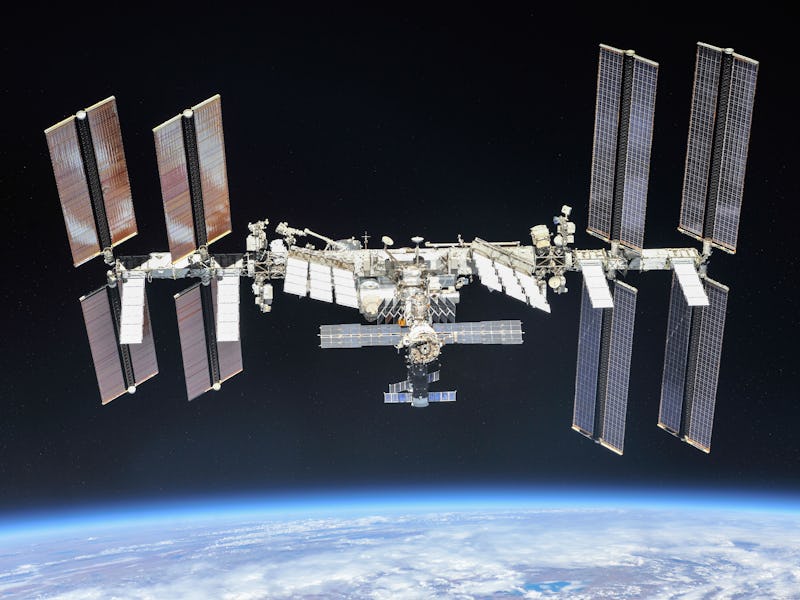NASA and Russia finally cement a plan to retrieve stranded astronauts on the ISS
The Russian Soyuz MS-22 capsule leaked what looked like “a visible stream of flakes” last month, and then stranded a crew in space.

A rescue plan has taken shape to bring home the two Russian cosmonauts and one NASA astronaut stranded on the International Space Station (ISS).
Last month, a Russian Soyuz MS-22 crew capsule docked at the ISS sprung a massive leak. The material was liquid coolant, and with so much lost to space, NASA and Russian space agency Roscosmos had to determine if the trio that rode the MS-22 into space could safely return to Earth come March, at the end of their mission. But they found that the vehicle was unsafe for a crew to ride back home because the thermal protection system was now compromised.
Roscosmos will launch an empty Soyuz MS-23 in February to retrieve NASA astronaut Frank Rubio and Russian cosmonauts Sergey Prokopyev and Dmitri Petelin. “The Soyuz MS-22 will be replaced by the Soyuz MS-23 spacecraft that will launch to the space station without a crew on Monday, Feb. 20,” NASA press officials wrote Wednesday on the agency’s Space Station blog.
“We are going to return back Soyuz [MS-22] with no crew … we are sending new Soyuz with empty seats to be able to rescue crew and return them back in nominal situation,” Sergei Krikalev, executive director of the Roscosmos Human Space Flight Programs, told reporters at a joint teleconference with NASA on Wednesday.
The trio will not board next month when the spacecraft arrives. They are now set to spend extra months on the ISS as part of the recovery plan.
Soyuz leak: what you need to know
The December 14, 2022 leak looked like a “visible stream of flakes,” NASA communications officer Rob Navias described the sight during a live stream. The coolant leak happened less than two hours before a scheduled spacewalk, so NASA caught the footage as part of their typical coverage of the extravehicular activity. The dramatic scene immediately raised a question of whether or not the Expedition 68 trio who rode up aboard the MS-22 would face a hurdle to come home when their mission was scheduled to initially end in March 2023. Crew capsules perform both the outbound and return trips. The three spacefarers hitched a ride to low-Earth orbit on September 21 onboard the now-damaged MS-22 capsule.
“The crew members aboard the space station are safe, and were not in any danger during the leak,” NASA’s Space Station blog previously said. “The space station is in good condition, and the Expedition 68 crew is safe,” NASA’s Space Station Twitter account also tweeted the day of the leak.
“Ground teams in Moscow are evaluating the nature of the fluid and potential impacts on the integrity of the Soyuz spacecraft, which carried Prokopyev, Petelin, and NASA astronaut Frank Rubio into space after launching from the Baikonur Cosmodrome in Kazakhstan on Sept. 21,” NASA shared on the day of the leak in a blog post.
“The cosmonauts did not exit the space station, and no crew members were exposed to the leaking coolant,” NASA wrote in another update.
In a later post, NASA officials shared that the suspected leak source is “the external radiator cooling loop of the Soyuz.” That turned out to be the case.
According to a post from the Russian state news agency TASS, their preliminary assessment shows that the leak came from damage to “the external casing of the Soyuz MS-22 crew spacecraft’s instrumentation and equipment compartment.”
On January 11, NASA and Roscosmos officials announced that the likely culprit was a micrometeoroid strike. Krikalev told reporters that the issue did not stem from faulty manufacturing.
Following the December 14 leak, former NASA astronauts took to Twitter to voice their concerns. Former Twins Study U.S. astronaut Scott Kelly called the leak a “serious situation.” Canadian astronaut Chris Hadfield shared his thoughts via the social media platform, too, also describing its nature as “serious” and adding, “Not good, lots of fast decision-making going on.”
This article was originally published on